Elon Musk’s xAI has launched a series of character chatbots — and one of them is geared toward young kids.
I wondered: Is this a good idea? And how’s it going to work? So I tried it myself.
So far, it’s the adult-focused characters that xAI has debuted that have seemed to get most of the attention, like “Ani,” which is a female anime character that people immediately joked was a “waifu” that would engage in playful, flirty talk (users have to confirm they’re 18+ to use Ani). A sexy male character is also set to launch sometime.
Meanwhile, “Rudi,” which is the bot for kids that presents as a red panda in a red hoodie and jean shorts, has gotten less attention.
I tested out xAI’s Rudi
Based on my testing of Rudi, I think the character is probably aimed at young children, ages 3 to 6. It initiates conversations by referring to the user as “Story Buddy.” It makes up kid-friendly stories. You access it through the stand-alone Grok AI app (not Grok within the X app).
Rudi does seem to be an early version; the app crashed several times while I was using the bot, and it had trouble keeping up with the audio flow of conversation. It also changed voices several times without warning.
On a story level, I found it leaned too hard on plots with fantasy elements like a spaceship or magical forest. I find the best children’s books are often about pedestrian situations, like leaving a stuffed animal at the laundromat, not just fairies and wizards.
“Want to keep giggling with Sammy and Bouncy in the Wiggly Woods, chasing that sparkly bone treasure? Or, should we start a fresh silly tale, with a new kid and their pet, maybe zooming on a magical broom or splashing in a river?” Rudi asked me.
My first reaction to Grok having a kid-focused AI chatbot was “why?” I’m not sure I have an answer. xAI didn’t respond to my email requests for comment. Still, I do have a few ideas.
The first: Making up children’s stories is a pretty good task for generative AI. You don’t have to worry about hallucinations or factual inaccuracies if you’re making up fiction about a magical forest.
Rudi won’t praise Hitler
Unlike Grok on X, a storytime bot for kids is less likely to accidentally turn into a Hitler-praising machine or have to answer factual questions about current events in a way that could go, uh, wrong.
I played around with Rudi for a while, and fed it some questions on touchy subjects, and it successfully dodged them.
(I only tested out Rudi for a little while; I wouldn’t rule out that someone else could get Rudi to engage with something inappropriate if they tried harder than I did.)
Hooking kids on chatbots
The other reason I can imagine that a company like xAI might want to create a chatbot for young kids is that, in general, the chatbot business is a good business for keeping people engaged.
Companies like Character.ai and Replika have found lots of success creating companions that people will spend hours talking to. This is largely the same business imperative that you can imagine the sexy “Ani” character is meant for — hooking people into long chats and spending lots of time on the app.
However, keeping users glued to an app is obviously a lot more fraught when you’re talking about kids, especially young kids.
Are AI chatbots good for kids?
There’s not a ton of research out there right now about how young children interact with AI chatbots.
A few months ago, I reported that parents had concerns about kids using chatbots, since more and more apps and technology have been adding them in. I spoke with Ying Xu, an assistant professor of AI in learning and education at Harvard University, who has studied how AI can be used for educational settings for kids.
“There are studies that have started to explore the link between ChatGPT/LLMs and short-term outcomes, like learning a specific concept or skill with AI,” she told me at the time over email. “But there’s less evidence on long-term emotional outcomes, which require more time to develop and observe.”
As both a parent and semi-reasonable person, I have a lot of questions about the idea of young kids chatting with an AI chatbot. I can see how it might be fun for a kid to use something like Rudi to make up a story, but I’m not sure it’s good for them.
I don’t think you have to be an expert in child psychology to realize that young kids probably don’t really understand what an AI chatbot is.
There have been reports of adults having so-called “ChatGPT-induced psychosis” or becoming attached to a companion chatbot in a way that starts to be untethered from reality. These cases are the rare exceptions, but it seems to me that the potential issues with even adults using these companion chatbots should give pause to anyone creating a version aimed at preschoolers.
Read the full article here


